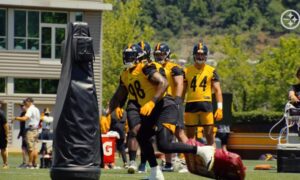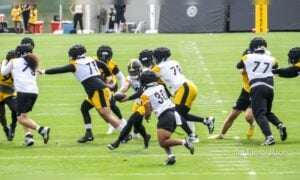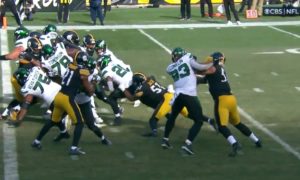Few players on the Pittsburgh Steelers current roster have been criticized as much as outside linebacker Jarvis Jones throughout the edge rusher’s first two seasons, but how much of that negative stigma is warranted?
As the 17th overall pick in the 2013 NFL Draft, Jones was drafted largely because he was believed to be an exceptional athlete off the edge, with the ability to add the necessary muscle to hold up as a run defender as his NFL career progressed. Because of his high draft selection and the Steelers growing need for pass rushing help over the past two seasons, much has been expected of the young edge rusher, and there is no question that Jones has struggled, at least in the production area.
So what has led to the Georgia product’s statistical ineptitude? Is it a scheme or usage issue, or does Jones lack the technique and/or ability to be effective?
The second piece of a two-part series, the first of which detailed Jones’ work as a pass rusher, today we’ll take a look at the outside linebacker’s run-stopping prowess on the edge in 2015.
Play #1
The Game: Week 1 vs. Cleveland Browns
The Situation: :04, 1st Quarter
One of the most important aspects of run defense is playing assignment-sound football, which, as a 3-4 outside linebacker, typically means not losing the edge. Here we’ll see how Jones handles some trickery from his right outside linebacker spot, and struggles to control the boundary because of his lack of awareness.
Right off the snap Jones crashes hard to pursue the apparent stretch play to the opposite side of the field, moving down the LOS quickly as the backside help. While you have to admire the aggressiveness to chase down plays from behind (something Jones does well), he need to understand that he still has containment and must keep his head on a swivel for a possible reverse or counter back to his side of the field. He cannot lose that edge.
Unfortunately Jones recognizes the reverse too late and is already too far out of position to recover and keep Travis Benjamin from gaining the boundary. The third-year defender is simply not an elite enough athlete to change directions on a dime and make this type of a stop in the open field.
By giving up outside containment and failing to realize the deception before it occurred, Jones gives up ten yards and a big play on 2nd-and-14. The desire to be aggressive is a positive, but Jones must play with better control and awareness than he exhibits here. Over-pursuing plays was one of his biggest issues in college, and it continues to plague him in the NFL.
Play #2
The Game: Week 1 vs. Cleveland
The Situation: 7:05, 2nd Quarter
One of Jones’ biggest advantages as a defender is his straight-line burst off the snap. The Steelers edge defender can get upfield in a hurry and be disruptive, but his ability to make plays in space has come under fire in the NFL, and rightfully so.
Again Jones is charged with outside containment, only this time he correctly identifies the play and bursts upfield off the snap before the fullback can ready himself for a block. Jones avoids the sloppy cut block fairly well and keeps his balance, only giving up a step or so to Ben Tate in the process.
Now Tate is not an exceptionally shifty or elusive runner in space, so this is the type of stop Jones’ needs to make in order to compensate for his issues stacking-and-shedding blocks on the interior.
Unfortunately Jones’ not only fails to make the play, he wipes out completely when trying to turn the corner and keep Tate from reaching the boundary. If this was a once-in-a-blue moon type of play, perhaps we chalk it up to Jones simply losing his balance, but it is not. As Steelers’ supporters and analysts, we must accept the fact that Jones is simply not the athlete that he was once heralded to be by many pundits, and that making plays in space, even against less athletic backs, might never be his strong suit.
Play #3
The Game: Week 2 vs. Baltimore Ravens
The Situation: 8:44, 2nd Quarter
Any analysis of Jarvis Jones run defense skills wouldn’t be complete without highlighting perhaps his biggest struggle, the ability to get off blocks. When plays are run right at him, Jones really labors to stack-and-shed at the point of attack, sometimes failing to discard the block altogether.
It should be noted that Jones does play assignment sound here, getting upfield quickly and setting the edge to keep Bernard Pierce from bouncing this run outside to the boundary. As we mentioned before, this is one of the key aspects of playing 3-4 outside linebacker, and Jones successfully forces Pierce back inside with stellar positioning and anticipation to contain the play.
While his awareness is to be applauded on this play, Jones is fairly mauled by Eugene Monroe at the point of attack, getting pushed several yards down field and failing to disengage and aid in the stop. Ideally you’d like to see Jones combine his cerebral play with physical ability here, but again his issues with power surface.
Jones isn’t a lost cause as a run defender, as his upfield burst, ideal length, and effort to chase plays down from the backside show up on tape. But at his position you want to see more ability and agility to make stops in space, and that simply hasn’t been in Jones’ repertoire during his two years in the NFL. Combine these struggles with his glaring issues stacking and shedding blocks at the line of scrimmage, and you have a player who will struggle when asked to make plays against the run on a consistent basis. His effort and linear burst make him adequate, but Jones might never be starter material as a run defender in the NFL.











